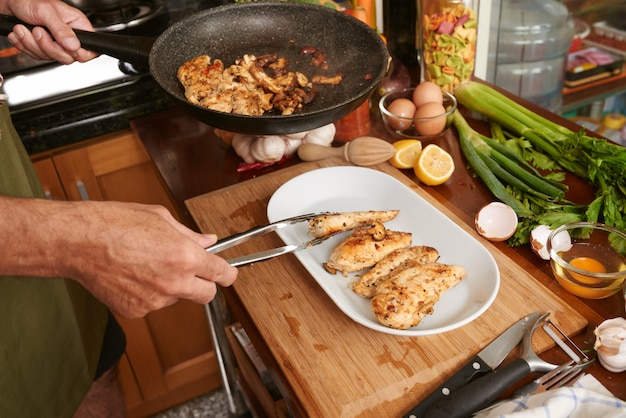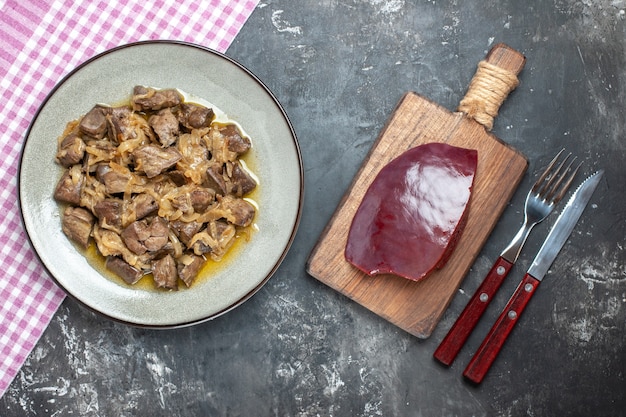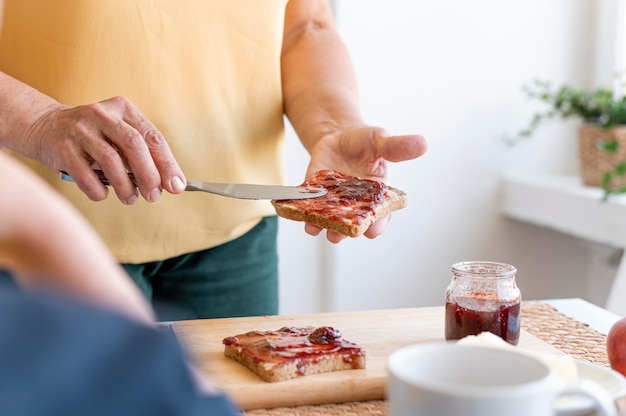Oh, pork chops. Those beautiful, versatile cuts of meat are a staple in many kitchens, and for good reason. They're easy to cook, affordable, and incredibly flavourful. But here's the thing: a perfect pork chop isn't just about throwing it in a pan and calling it a day. It's about achieving that sweet spot where the meat is cooked just right, juicy and tender, without being dry or tough. That's where temperature comes in. I've spent countless hours in the kitchen, experimenting and learning, and I'm ready to share my secrets with you. Let's get cooking!
Part 1: The Science Behind a Delicious Pork Chop

The Importance of Temperature
Think of a pork chop as a delicate little instrument. If you play it too softly, it won't sing. Play it too hard, and it'll crack. It's the same with cooking. Pork has a specific range where it shines – the "sweet spot" where the proteins are cooked just enough to be safe and delicious.
The USDA recommends cooking pork to an internal temperature of 145°F (63°C) to eliminate harmful bacteria. But don't stop there! This temperature is merely the minimum for safety. To achieve that glorious texture and flavour we all crave, we need to aim for a slightly higher temperature, depending on our preferred level of doneness.
Unveiling the Temperature Zones
Imagine a spectrum of doneness, each point offering a unique flavour and texture profile:
- Undercooked (130°F - 140°F): While technically safe, it's likely to be pink and a bit chewy. You might encounter this if you're aiming for a very rare chop, but it's not ideal for most people.
- Medium-Rare (140°F - 145°F): This is the magic zone for a juicy, tender pork chop with a slight pinkness in the center. It's a popular choice for those who appreciate a bit of pinkness but want a safe and flavourful chop.
- Medium (145°F - 150°F): The pink fades, leaving a beautifully cooked chop that's still moist and full of flavour. This is a great option for those who prefer a slightly more cooked pork chop, but don't want it to become dry.
- Medium-Well (150°F - 155°F): The chop starts to dry out a bit, but it's still tasty and perfectly safe.
- Well-Done (155°F - 160°F): The pork chop is fully cooked through, but it can be quite dry, losing its juiciness and tenderness. It's best to avoid this zone unless you prefer a well-done texture.
Remember, these are just guidelines. Experiment and find your perfect temperature zone based on your own preferences. There's no right or wrong, only what tastes best to you!
Part 2: Equipping Your Kitchen for Pork Chop Perfection

Essential Tools for a Winning Meal
You don't need a fancy kitchen to cook amazing pork chops. A few essential tools will take you far. Here's what I recommend:
- A meat thermometer: This is your best friend when it comes to pork chops. Forget relying on your gut instinct or colour alone – a meat thermometer provides precise measurements for consistently perfect results.
- A cast iron skillet: This kitchen workhorse is ideal for searing pork chops, creating those beautiful crispy edges that add a delicious layer of flavour.
- A Baking Sheet: For oven-baked pork chops, a baking sheet provides a sturdy platform for even cooking.
Choosing the Perfect Pork Chop: It's All About the Cut
You can't just grab any old pork chop and expect greatness. Take a moment to choose the right cuts for a truly delicious experience. Here's what to consider:
- Thickness: Aim for chops that are at least an inch thick. These beauties will cook more evenly and retain their juiciness better than thinner cuts.
- Marbling: Look for those lovely streaks of fat running through the meat. Marbling adds flavour and keeps the chop juicy and tender.
- Colour: The chop should be a pale pink colour with a slight creamy hue. Avoid any that look grey or discolored.
Remember, a good butcher can be a valuable resource. Don't be afraid to ask for advice on choosing the best pork chops for your needs.
Part 3: Seasoning the Star of the Show

Simple Seasoning, Big Flavour
When it comes to seasoning, less is often more. Pork chops are naturally flavourful, and you don't need a symphony of spices to enhance their deliciousness. Here's my go-to, and it works beautifully:
- Salt: A generous pinch of salt is essential for bringing out the natural flavour of the pork.
- Black Pepper: Freshly ground black pepper adds a bit of heat and depth to the flavour.
- Garlic Powder: A touch of garlic powder adds a lovely aroma and a subtle garlic flavour.
I like to season my chops generously with this simple blend about 30 minutes before cooking. This allows the salt to penetrate the meat and draw out moisture, resulting in a juicier and more flavourful chop.
Beyond the Basics: Exploring Flavour Combinations
Once you've mastered the basic seasoning, it's time to get creative! Here are a few flavour combinations that will elevate your pork chops to new heights.
- Mediterranean: A fragrant blend of rosemary, thyme, oregano, lemon zest, and garlic. This combination pairs beautifully with roasted vegetables like potatoes, peppers, and onions.
- Asian Inspired: A vibrant mix of ginger, soy sauce, sesame oil, and black pepper. This combination works well with stir-fried vegetables or rice noodles.
- Cajun: A fiery mix of paprika, cayenne pepper, garlic powder, and onion powder. This bold combination pairs well with cornbread or a creamy coleslaw.
Remember, the key is to use fresh, high-quality spices. This will make a world of difference in the flavour of your final dish.
Part 4: Mastering the Cooking Methods
The Pan-Seared Method: A Classic for a Reason
This method is a favourite among many cooks, and for good reason. It creates a beautiful sear, locking in the juices and giving the pork chop a lovely crispy exterior. Here's how to do it:
- Heat the Skillet: Get that cast iron skillet screaming hot over medium-high heat. You want it to be very hot when you add the pork chops.
- Sear the Chops: Add the seasoned pork chops to the hot skillet. Don't overcrowd the pan! Cook for 3-4 minutes per side, or until they're golden brown and nicely seared.
- Reduce the Heat: Turn the heat down to medium-low. Continue cooking for another 5-7 minutes, or until the internal temperature reaches 145°F (63°C).
- Rest: Remove the chops from the skillet and let them rest for 5-10 minutes before slicing and serving. This allows the juices to redistribute throughout the meat, resulting in a more tender and flavourful chop.
The Oven-Baked Method: Effortless and Delicious
This is a great method for when you want to cook several chops at once or if you prefer a hands-off approach. It's simple and yields fantastic results.
- Preheat the Oven: Set your oven to 400°F (200°C).
- Season the Chops: Generously season your pork chops with salt, pepper, and any other spices you like.
- Bake the Chops: Place the seasoned pork chops on a baking sheet and bake for 15-20 minutes, or until the internal temperature reaches 145°F (63°C).
- Rest: Remove the chops from the oven and let them rest for 5-10 minutes before slicing and serving.
For a more flavorful result, consider adding a little bit of liquid, like chicken broth or apple cider, to the baking sheet before adding the chops. This will help to create a delicious pan sauce that you can drizzle over the cooked chops.
Part 5: The Meat Thermometer: Your Guide to Perfection
Unmasking the Meat Thermometer
The meat thermometer is an essential tool for any cook. It takes the guesswork out of cooking, ensuring that your pork chops are cooked to your preferred level of doneness every time.
Most meat thermometers have a long, thin probe that you insert into the thickest part of the pork chop, making sure to avoid any bones. You want to check the temperature in the center of the meat, not near the edges where it might be hotter.
Reading the Thermometer: Decoding the Numbers
The thermometer will display the temperature in either Fahrenheit or Celsius. We're aiming for 145°F (63°C) for safe and delicious pork chops, but remember, you can adjust that target temperature based on your preferred level of doneness.
Safety First: Using the Thermometer Correctly
It's important to completely insert the thermometer into the pork chop and leave it for a few seconds to ensure an accurate reading. Don't be tempted to pull it out too quickly!
If you find that your chops are not cooked through to your desired temperature, simply return them to the heat source and continue cooking until they reach the desired temperature.
Part 6: The Final Touches: Serving and Sides
Resting the Pork Chops: The Secret to Tenderness
After cooking, resist the urge to immediately slice and serve your pork chops. Let them rest for at least 5-10 minutes. This allows the juices to redistribute throughout the meat, resulting in a more tender and flavorful chop.
Perfect Pairings: Sides for Your Pork Chops
Pork chops are incredibly versatile and pair beautifully with a wide range of sides. Here are some classic and creative combinations that will make your meal complete.
- mashed potatoes: Creamy and comforting, mashed potatoes are a classic pairing for pork chops. They offer a rich contrast to the flavour and texture of the meat.
- Roasted Vegetables: A colourful array of roasted vegetables adds both flavour and texture to your plate. Try roasting sweet potatoes, Brussels sprouts, carrots, or asparagus with a drizzle of olive oil, salt, and pepper.
- Green Salad: A fresh green salad provides a lighter and refreshing element to your meal.
- Applesauce: A sweet and tangy counterpoint to the savoury pork chop.
- Polenta: Creamy and comforting, polenta offers a smooth texture that contrasts beautifully with the crispy exterior of a pan-seared pork chop.
- rice pilaf: A simple and flavorful rice pilaf is a delicious and versatile side that complements pork chops beautifully.
Don't be afraid to experiment with different combinations and find your own personal favourites!
Part 7: FAQs: Your Pork Chop Questions Answered
Frequently Asked Questions
- Q: What if I overcook my pork chops?
A: overcooked pork chops can be a bit dry, but don't despair! You can add some moisture back by adding a bit of sauce or gravy. A pan sauce made with the drippings from the skillet, or a creamy mushroom sauce can help to revive a slightly dry chop.
- Q: Can I cook pork chops in the slow cooker?
A: Absolutely! Pork chops are perfect for slow cooking. Just season them as you would for any other cooking method, and cook on low for 6-8 hours, or on high for 3-4 hours. The slow cooking process will tenderize the meat and produce a melt-in-your-mouth result.
- Q: How do I tell if pork chops are done without a meat thermometer?
A: It's tricky to tell if pork chops are done without a meat thermometer, as the colour can be deceiving. It's best to err on the side of caution and use a meat thermometer to ensure your pork chops are cooked to the safe temperature.
- Q: Can I freeze pork chops?
A: Yes, you can freeze pork chops. Wrap them tightly in plastic wrap or foil, and then place them in a freezer-safe bag. Frozen pork chops can last for up to 3-4 months in the freezer. Thaw them in the refrigerator overnight before cooking.
- Q: How do I reheat pork chops?
A: You can reheat pork chops in the oven or in the microwave. For the oven, preheat to 350°F (175°C) and bake for 10-15 minutes, or until heated through. For the microwave, heat on high for 30-60 seconds, or until heated through.
- Q: Can I cook pork chops in an air fryer?
A: Yes! Air fryers are a fantastic way to cook pork chops quickly and easily. Just season them as usual and cook at 400°F (200°C) for 8-10 minutes, or until the internal temperature reaches 145°F (63°C).
A: overcooked pork chops can be a bit dry, but don't despair! You can add some moisture back by adding a bit of sauce or gravy. A pan sauce made with the drippings from the skillet, or a creamy mushroom sauce can help to revive a slightly dry chop.
A: Absolutely! Pork chops are perfect for slow cooking. Just season them as you would for any other cooking method, and cook on low for 6-8 hours, or on high for 3-4 hours. The slow cooking process will tenderize the meat and produce a melt-in-your-mouth result.
A: It's tricky to tell if pork chops are done without a meat thermometer, as the colour can be deceiving. It's best to err on the side of caution and use a meat thermometer to ensure your pork chops are cooked to the safe temperature.
A: Yes, you can freeze pork chops. Wrap them tightly in plastic wrap or foil, and then place them in a freezer-safe bag. Frozen pork chops can last for up to 3-4 months in the freezer. Thaw them in the refrigerator overnight before cooking.
A: You can reheat pork chops in the oven or in the microwave. For the oven, preheat to 350°F (175°C) and bake for 10-15 minutes, or until heated through. For the microwave, heat on high for 30-60 seconds, or until heated through.
A: Yes! Air fryers are a fantastic way to cook pork chops quickly and easily. Just season them as usual and cook at 400°F (200°C) for 8-10 minutes, or until the internal temperature reaches 145°F (63°C).
Part 8: Embrace the Pork Chop Journey
There you have it, my friends, a comprehensive guide to cooking the perfect pork chop. It's all about getting that temperature just right, and with the right tools, a bit of practice, and a dash of creativity, you'll be a pork chop master in no time. Don't be afraid to experiment with different cooking methods, seasonings, and sides to find what you love. Remember, it's a journey, not a race. Happy cooking!
Everyone is watching

How to Cook Frozen Lobster Tails Perfectly: A Step-by-Step Guide
RecipesLobster. Just the word conjures up images of lavish meals, special occasions, and a taste of luxury. But let's...

Pigs in a Blanket Cooking Time: How Long to Bake for Perfect Results
RecipesAh, pigs in a blanket. Just the name conjures up images of those delightful little parcels of crispy pastry en...

Pork Fillet Cooking Time: How Long to Cook It Perfectly
RecipesPork fillet, or tenderloin as it's sometimes called, is a real favourite in our house. It's so versatile, and...

The Ultimate Guide to Cooking Delicious Frankfurters
RecipesLet's face it, we all love a good frankfurter. It's a classic, simple, and always satisfying. But let's be rea...

Wolf Meat Recipes: A Guide to Cooking Wild Game
RecipesLet's be honest, you don't see wolf meat at your local butcher shop every day. It's a bit of a wild card, but ...
